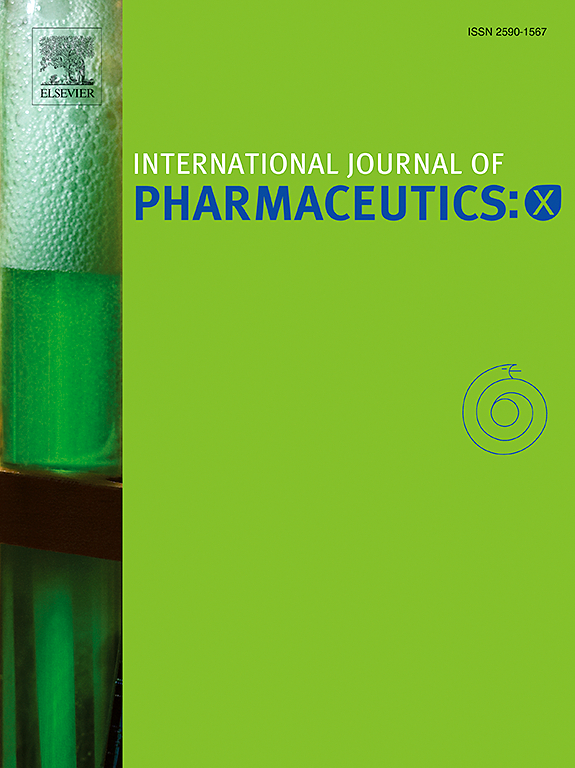Stabilising large biologics through complimentary buffer component protection and rapid drying times
IF 6.4
2区 医学
Q1 PHARMACOLOGY & PHARMACY
引用次数: 0
Abstract
High processing temperatures restrict spray drying applications for heat sensitive biologics. This work highlights the potential of Phosphate Buffer Saline (PBS) as the sole stabilising excipient when spray drying large biologics via a complimentary buffer component effect. Fibrinogen (∼340 kDa) was spray dried in PBS at various temperatures and concentrations, followed by assessment of the protein's structural integrity by UV–Vis, ATR-FTIR, SEM, and PXRD analyses. Experimental findings demonstrate that fibrinogen can maintain structural integrity when spray dried at temperatures up to 60 °C (Tout), when PBS is used as the sole stabilising excipient in combination with rapid drying rates. Results show a synergistic effect between the phosphate and salt components of the buffer when subjected to rapid drying rates mitigating protein aggregation and preserving protein secondary and tertiary structures. Stability studies conducted over 90 days indicated that powders stored under low humidity retained structural integrity. Findings provide valuable insights into the feasibility of spray drying large biologics through understanding the individual stabilising effects of PBS buffer components coupled with the rapid drying times. This approach offers a promising and scalable formulation strategy for the pharmaceutical industry in developing an alternative to freeze drying methods, offering advantages in cost, processing time, and product stability.

通过补充缓冲成分保护和快速干燥时间来稳定大型生物制品
高加工温度限制了热敏性生物制品的喷雾干燥应用。这项工作强调了磷酸盐缓冲盐水(PBS)作为唯一稳定赋形剂的潜力,当喷雾干燥大型生物制剂时,通过补充缓冲成分的作用。纤维蛋白原(~ 340 kDa)在不同温度和浓度的PBS中喷雾干燥,然后通过UV-Vis, ATR-FTIR, SEM和PXRD分析评估蛋白质的结构完整性。实验结果表明,当在高达60°C (Tout)的温度下喷雾干燥时,当PBS作为唯一的稳定辅料与快速干燥速率相结合时,纤维蛋白原可以保持结构完整性。结果表明,在快速干燥条件下,缓冲液中的磷酸盐和盐组分之间具有协同作用,可减轻蛋白质聚集并保存蛋白质的二级和三级结构。超过90天的稳定性研究表明,在低湿度下储存的粉末保持了结构完整性。研究结果通过了解PBS缓冲液成分的个别稳定作用以及快速干燥时间,为喷雾干燥大型生物制品的可行性提供了有价值的见解。这种方法为制药行业开发冷冻干燥方法的替代方案提供了一种有前途和可扩展的配方策略,在成本、处理时间和产品稳定性方面具有优势。
本文章由计算机程序翻译,如有差异,请以英文原文为准。
求助全文
约1分钟内获得全文
求助全文
来源期刊

International Journal of Pharmaceutics: X
Pharmacology, Toxicology and Pharmaceutics-Pharmaceutical Science
CiteScore
6.60
自引率
0.00%
发文量
32
审稿时长
24 days
期刊介绍:
International Journal of Pharmaceutics: X offers authors with high-quality research who want to publish in a gold open access journal the opportunity to make their work immediately, permanently, and freely accessible.
International Journal of Pharmaceutics: X authors will pay an article publishing charge (APC), have a choice of license options, and retain copyright. Please check the APC here. The journal is indexed in SCOPUS, PUBMED, PMC and DOAJ.
The International Journal of Pharmaceutics is the second most cited journal in the "Pharmacy & Pharmacology" category out of 358 journals, being the true home for pharmaceutical scientists concerned with the physical, chemical and biological properties of devices and delivery systems for drugs, vaccines and biologicals, including their design, manufacture and evaluation. This includes evaluation of the properties of drugs, excipients such as surfactants and polymers and novel materials. The journal has special sections on pharmaceutical nanotechnology and personalized medicines, and publishes research papers, reviews, commentaries and letters to the editor as well as special issues.
 求助内容:
求助内容: 应助结果提醒方式:
应助结果提醒方式:


